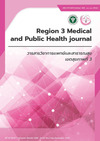Technique to reduce infection rate in external ventricular drainage : An experience from Uthaithani Hospital
Keywords:
external ventricular drainage, external ventricular drainage infection, ventricular catheter infection Medical doctorAbstract
Introduction : External ventricular drainage (EVD) surgery is the basic neurosurgery procedure for treating intracerebral hemorrhage (ICH) along with intraventricular hemorrhage (IVH). The main complications are infection and hydrocephalus. Best guidelines that reduce both of these complications remain the main concern for surgeons around the world
Objective : To report techniques that reduce infection in patients undergoing EVD.
Methodology : This was a retrospective cohort study conducted among the patients who had EVD in the Uthaithani Hospital between August 2020 and September 2022. A total of 64 cases were divided into two groups: those under the improved technique (case group, n=31) and the standard technique (control group, n=33). Both groups were investigated for EVD infections .
Results : There were 50.0% females in the case group and 46.4% in the control group (p-value=0.77). The mean age in the case group and the other group was 62.7±12.1 years and 62.1±13.9 years (p-value=0.85), respectively. 90.3% were diagnosed with hemorrhagic stroke in the case group and 87.9% in the control group (p-value=0.75). The mean ICH volume and IVH grading (Graeb score) were statistically insignificant (p-value=0.93 and p-value=0.73, respectively) between the groups. Likewise, the mean GCS score in the case group and the control group at admission and discharge was 9.5±3.0 vs 9.4±3.5 and 10.4± 4.2 vs 9.6±4.6, respectively. However, the average ICU stay in the case group was statistically higher (7.8±8.4 vs 14.5±11.6 days, p-value <0.01), and EVD infections were significantly lower (3.2%) than in the control group (27.3%). Regarding multiple logistic regression analysis, the infection reduction technique group was able to reduce the incidence of infection by 91%, with statistical significance (adjust oddsratio=0.09; 95% ConfidenceInterval:I 0.01-0.90; p-value 0.04).
Conclusion : The infection reduction technique in the study was effective in reducing the infection rate.
Keywords : external ventricular drainage, external ventricular drainage infection, ventricular catheter infection Medical doctor
References
Adams RE, Diringer MN. Response to external ventricular drainage in spontaneous intracerebral hemorrhage with hydrocephalus. Neurology. 1998;50:519 –5
Ramanan M, Lipman J, Shorr A, Shankar A. A meta-analysis of ventriculostomy-associated cerebrospinal fluid infections. BMC Infect Dis. 2015; 15:1–12.
Lewis A, Wahlster S, Karinja S, Czeisler BM, Kimberly WT, Lord AS. Ventriculostomy-related infections : The performance of different definitions for diagnosing infection. Br J Neurosurg. 2016; 30:49–56.
Baum GR, Hooten KG, Lockney DT, Fargen KM, Turan N, Pradilla G, Murad GJA, Harbaugh RE, Glantz M. External ventricular drain practice variations : results from a nationwide survey. J Neurosurg. 2017 Nov;127(5):1190-1197.
Edlich RF, et al. Dangers of cornstarch powder on medical gloves: seeking a solution. Ann Plast Surg. 2009;63(1):111-115.
Van den Tol MP, et al. Glove powder promotes adhesion formation and facilitates tumour cell adhesion and growth. Br J Surg. 2001;88(9) : 1258-1263.
Tulipan N, Cleves MA. Effect of an intraoperative double-gloving strategy on the incidence of cerebrospinal fluid shunt infection. J Neurosurg. 2006; 104(1 Suppl):5–8.
Van de Beek D, Drake JM, Tunkel AR. Nosocomial bacterial meningitis. N Engl J Med. 2010;362(2) : 146–154.
Lozier AP, Sciacca RR, Romagnoli MF, et al. Ventriculostomy-related infections: A critical review of the literature. Neurosurgery. 2002;51 (1):170–182.
Mounier R, Lobo D, Cook F, Martin M, Attias A, Aït-Mamar B, et al. From the Skin to the Brain: Pathophysiology of Colonization and Infection of External Ventricular Drain, a Prospective Observational Study. PLoS ONE 2015 ; 10(11): 1-15.
ประดิษฐ์ ไชยบุตร. บทสรุปเรื่องภาวะวิกฤตด้านศัลยกรรมระบบประสาท ในประเทศไทย.วารสารประสาทศัลยศาสตร์ ปีที่ 12 ฉบับที่ 2 กรกฎาคม - ธันวาคม 2564 : 93-98. นฤภัค รัศมียูงทอง , กุลพัฒน์ วีรสาร. ความสัมพันธ์ระหว่างจำนวนเตียงหอผู้ป่วยวิกฤติประสาท ศัลยศาสตร์ตอัตรา การตายในโรคหลอดเลือดสมองแตก ในโรงพยาบาลศูนย์ในประเทศไทย.วารสารประสาทศัลยศาสตร์ ปีที่ 12 ฉบับที่ 2 กรกฎาคม - ธันวาคม 2564 : 93-9
Downloads
Published
How to Cite
Issue
Section
License
Copyright (c) 2023 Region 3 Medical and Public Health Journal - วารสารวิชาการแพทย์และสาธารณสุข เขตสุขภาพที่ 3

This work is licensed under a Creative Commons Attribution-NonCommercial-NoDerivatives 4.0 International License.



